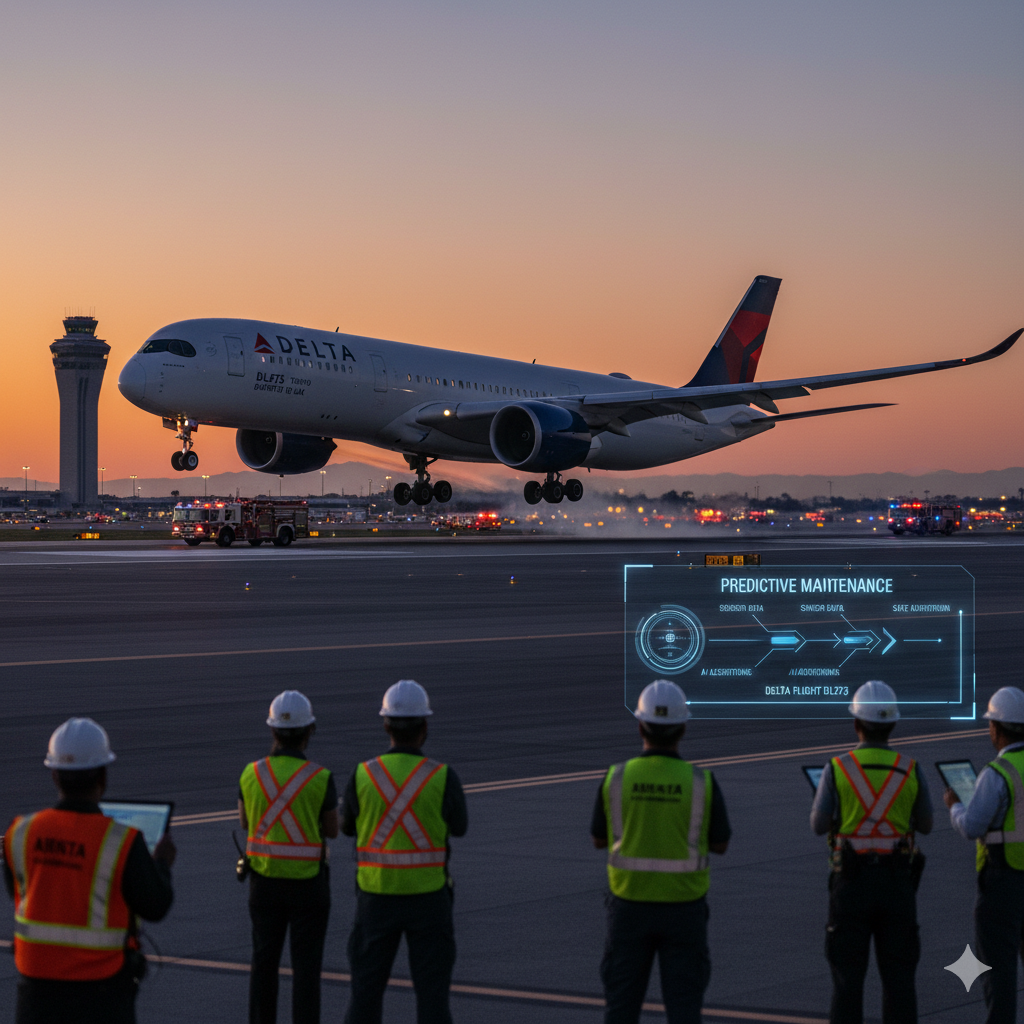Airline safety has always been under the spotlight, and unexpected incidents often highlight the importance of advanced technology in aviation. One such case recently gained attention when delta flight DL275 diverted LAX during a long-haul trip from Detroit to Tokyo. The diversion, while executed safely, exposed the crucial role of predictive maintenance and decision-making in ensuring passenger safety.
This article breaks down the event, explains why Los Angeles International Airport (LAX) was chosen, and what this means for travelers, airlines, and the future of air travel.
Quick Overview of Delta Flight DL275 Diversion
To better understand the scale of this event, here is a detailed summary of delta flight DL275 diverted LAX:
| Flight Route | Aircraft | Diverted To | Reason | Time in Air | Estimated Cost |
| Detroit (DTW) to Tokyo (HND) | Airbus A350-900, Reg. N508DN | Los Angeles International Airport (LAX) | Engine anti-ice system malfunction | 12 hours 15 minutes | $2.3 million |
The Timeline of the Incident
On May 27, 2025, Delta flight DL275 departed Detroit Metropolitan Wayne County Airport at 15:53 local time. The flight was already delayed due to a late inbound aircraft from Amsterdam.
For several hours, the journey was uneventful until the aircraft was cruising at 38,000 feet, about 620 nautical miles southwest of Anchorage, Alaska. At this point, the pilots noticed a malfunction in the Rolls-Royce Trent XWB engine’s anti-ice system. Such a failure in icy upper-atmosphere conditions could compromise flight safety.
Instead of risking further flight across the Pacific or attempting to return to Detroit, the pilots made a critical decision. They chose Los Angeles International Airport (LAX) as the diversion point. After 12 hours and 15 minutes in the air, delta flight DL275 diverted LAX and landed safely at 01:08 AM on May 28, 2025.
Why Los Angeles Was the Emergency Landing Choice
The choice of LAX was not random. It was based on three key factors that ensured passenger safety and operational efficiency:
1. Technical Infrastructure
LAX serves as a major Delta hub and provides certified Airbus A350 maintenance facilities. More importantly, it has 24/7 Rolls-Royce support for the Trent XWB engines, making it the ideal location for handling such a technical malfunction.
2. Passenger Convenience
Los Angeles is one of the busiest airports in the world and offers multiple daily flights to Tokyo. This meant passengers could be quickly rebooked or provided with accommodation without severe disruptions to their travel plans.
3. Emergency Readiness
The airport’s long runways, favorable weather conditions, and reliable emergency services made it the safest option for a heavy aircraft carrying significant fuel reserves.
Could Technology Have Prevented the Diversion?
The incident raises questions about whether the failure was avoidable. Aviation experts point out that predictive analytics and AI-driven diagnostics could have detected the issue before the plane ever left Detroit.
How Smart Tech Could Help:
- Real-time engine monitoring could identify early signs of irregularities in the anti-ice system.
- AI diagnostics during pre-flight checks might alert maintenance teams of potential failures.
- Proactive intervention could prevent costly diversions, fuel wastage, and disruption for passengers.
The diversion of delta flight DL275 diverted LAX is a reminder that while modern aircraft are highly advanced, the future of aviation lies in proactive, tech-enabled safety measures.
Impact on Travelers
For passengers booked on related routes, the diversion had ripple effects.
- Delta app updates provided real-time rebooking options.
- Some passengers faced delays or were shifted to alternative aircraft.
- Compensation and hotel accommodations were issued for those affected by connecting flight disruptions.
Despite the inconvenience, passengers praised the professionalism of the crew and pilots, who communicated effectively and kept everyone calm throughout the diversion.
Delta’s Official Response
While Delta has yet to release a detailed press statement, internal reports confirm that:
- All passengers and crew were unharmed.
- The pilots and flight attendants followed safety protocols with precision.
- Engineers are now working with Rolls-Royce specialists to investigate the cause and prevent similar occurrences.
The handling of delta flight DL275 diverted LAX has been praised as an example of effective crisis management in aviation.
Lessons for Aviation Safety
The diversion of this flight demonstrates how even top-tier airlines and advanced aircraft face challenges. However, it also highlights the importance of three evolving areas:
- Predictive Maintenance – Using AI to detect faults before they occur.
- Passenger Communication – Keeping travelers informed during disruptions builds trust.
- Operational Preparedness – Choosing diversion airports with the right technical and logistical infrastructure.
In this case, LAX proved to be the best choice, minimizing risk while maximizing safety and efficiency.
What This Means for Future Air Travel
The aviation industry continues to evolve, and incidents like this remind us that proactive safety measures are not optional—they are essential. As aircraft technology becomes more advanced, airlines must adopt smarter systems that predict and prevent failures.
For passengers, it also reinforces the importance of monitoring flight updates, staying connected through airline apps, and being aware of travel insurance policies in case of delays.
Ultimately, the safe landing of delta flight DL275 diverted LAX is proof of the skill of Delta’s crew and the resilience of modern aviation systems.
FAQs About Delta Flight DL275
Q1. Why did delta flight DL275 diverted LAX instead of continuing to Tokyo?
The pilots identified a malfunction in the engine’s anti-ice system, which posed a safety risk. LAX was chosen because of its technical facilities, emergency services, and passenger support systems.
Q2. Were passengers on delta flight DL275 safe?
Yes, all passengers landed safely at LAX, and no injuries were reported. The crew handled the emergency professionally.
Q3. How much did the diversion cost Delta?
The estimated cost of the diversion was around $2.3 million, considering fuel, maintenance, and passenger compensation.
Q4. Could advanced technology have prevented the diversion?
Yes. Predictive analytics and AI-driven diagnostics could have flagged the anti-ice system issue before departure, potentially preventing the diversion.
Q5. What should passengers do if their flight is diverted?
Passengers should stay calm, follow crew instructions, and check the airline’s app for rebooking and compensation options.
Conclusion
The case of delta flight DL275 diverted LAX is more than just an emergency landing—it is a lesson in modern aviation safety. While all passengers arrived safely, the incident exposed how reactive maintenance is no longer enough in today’s complex aviation landscape.
The future of air travel lies in predictive technology, smarter monitoring, and proactive safety measures. For airlines, this means fewer costly diversions, and for passengers, it means greater peace of mind when flying across the globe.




